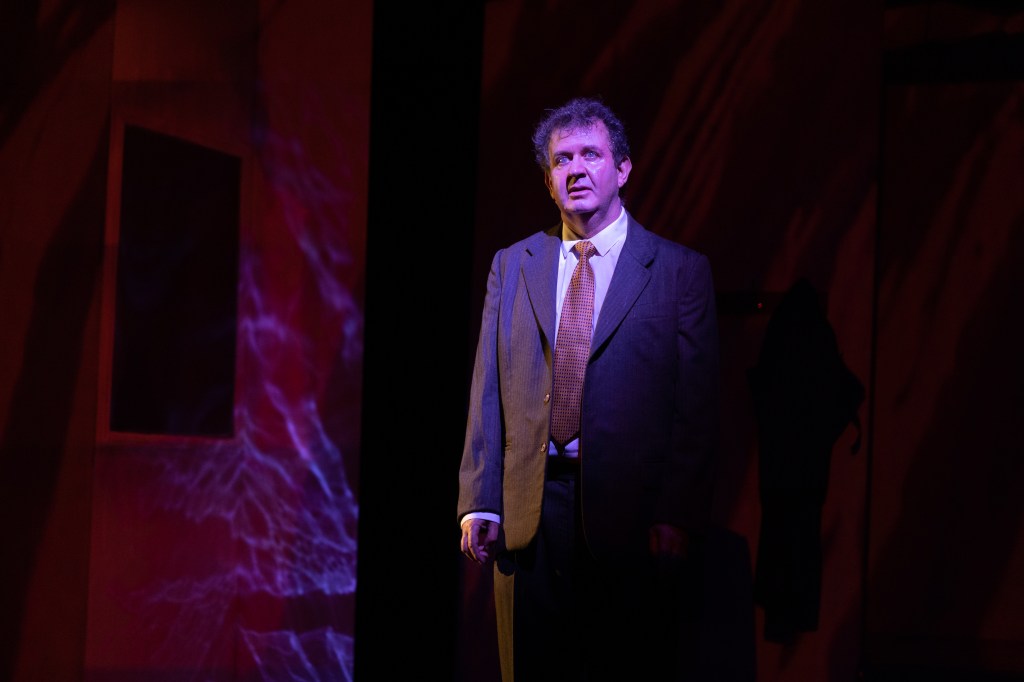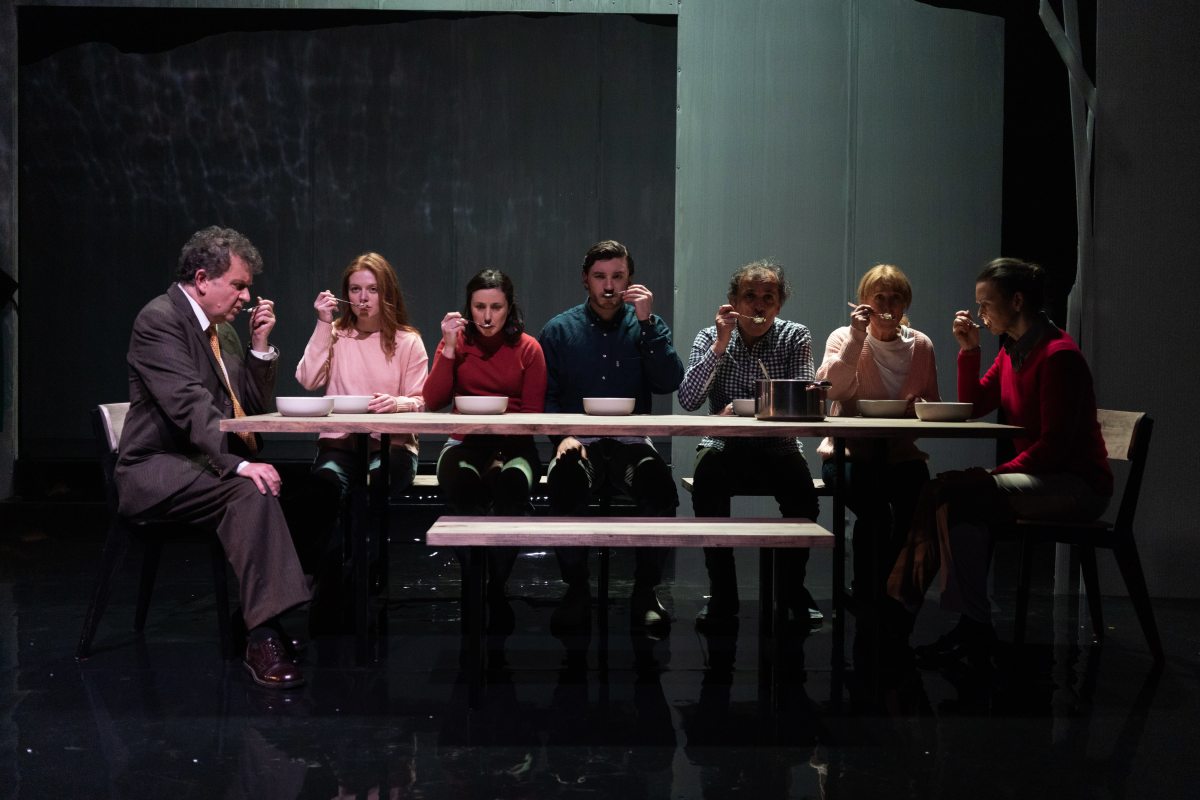It opens with a storm-silhouetted frame, bodies grasping umbrellas – thunder rumbles, lightning strikes. The rain has started falling. A fish falls from the sky – a family gathers together at a long timber table, connected across time and space, to urinate, then eat fish soup together. Nothing is quite what it seems.
This performance of Andrew Bovell’s When the Rain Stops Falling, directed by Co-Artistic Director of Iron Lung Theatre, Briony Dunn, features a cast of heavy-hitting actors – all at the top of their game. And it’s easy to see the attraction. The writing has much to offer: a family drama full of bitter bite – a language-lover’s delight.
Bovell has been a mainstay of Australian writing for decades – monologues from his 1998 play Speaking in Tongues were on all the audition lists at every major drama school in the country when I was applying in the mid-2000s – he does write a killer monologue.
As with Speaking in Tongues, the structure of the When the Rain Stops Falling is complex. Time is contracted: we experience the beginning, middle and end of a family saga – a tragedy that has repercussions across generations – in snippets and all at once. The domestic family scenes set around a dining table dovetail and the connections in the layers of storytelling reveal themselves through snapshots in time.
If it sounds confusing, well, it can be.
The story, as already mentioned, starts with a fish falling from the sky – in the opening monologue performed by well-known and wonderful actor Francis Greenslade, we learn it is some sort of near-future, where (we presume) environmental collapse has meant that fish are a rare sighting.
We step back in time – we meet an elderly Elizabeth (Heather Mills) and her son Gabriel (UK-born Darcy Kent). Gabriel wants to know what has happened to his father, who disappeared years earlier. Another jump back: we are in 1960s London, where Henry Law (played again by Francis Greenslade) and his wife, Elizabeth (performed by Esther Van Doornum), discover Elizabeth is pregnant with their soon-to-be son, Gabriel. We follow Gabriel as an adult, as his search for his missing father leads him to the centre of Australia, falling in love along the way with an Australian woman, Gabrielle York (Lucy Chaix), who works in a pub in Coorong.
We are also privy to scenes from Gabrielle’s life as an older woman (performed by Heather Bolton) with her new husband, Joe (Chris Connelly), Gabrielle’s son to Gabriel (also performed by Francis Greenslade) – and their son (Darcy Kent in another double-up) – four generations of a family story.
The frequent time-shifts between scenes and the fact that multiple characters from different time periods are performed by the same actors does lead to a sense of confusion at times – which one is this? Where are we again? – but the strong acting and some of the clearly time-period specific costumes, by costume designer Betty Auhl (Gabriel and Gabrielle are both in very 80s-looking stonewash jeans, Gabrielle in a parachute jacket) do assist in certain instances.

We discover secrets about the past – riddles are solved, tragedies are revealed. It’s high-stakes stuff: Drama with a capital ‘D’. The cloud of mystery at the heart of the play, when discovered, does feel a bit like a shortcut to wringing emotion from a story. I won’t spoil it, as it’s a reveal, but for those interested in content warnings: check When the Rain Stops Falling’s accessibility notes.
The theme of ‘place’ features prominently – and is imbued with deep psycho-geographic meaning. The set, by set designer Greg Clarke, is a simply dressed family home with a long timber dining table, framed by a series of white parallel wings, which together form an outline of Uluru as proscenium arch.
Later in the play, as the significance of Uluru becomes clearer, we see the whiteness of the set lit up in blood red – the projection (by Justin Gardam) a textured rendering of that highly culturally symbolic place – which would have been returned to the Anangu people, its Traditional Owners, in 1985, only a few years before Gabriel comes here searching for his father. It’s a powerful moment – and here the set design and accompanying lighting and projection pays off.
The story feels laden with symbolism at all turns – the biblical-like fish falling from the sky, even the repetition of the name ‘Gabriel/Gabrielle’ across generations invokes Gabriel the Archangel, the voice of God on Earth – the harbinger of prophesy – while also seemingly referencing that other intergeneration family saga full of name repetition, Gabriel García Márquez’s One Hundred Years of Solitude. As in that novel, in the play there is the hint of a family curse – as the family patriarch Henry Law holds a secret that has repercussions for generations to come.
That theme of Australian literature, the ‘lost child’, features prominently in this story – Gabrielle’s brother disappeared at the age of seven, in 1968. Set against this striking backdrop, one can’t help but draw the parallel to the story of Azaria Chamberlain.
For all its centring of story at Uluru – the Indigenous significance of the place is not discussed in this play, although we can’t help but feel it there, in our internal cringe at Henry Law’s naming it ‘Ayers Rock’, as was done in the 60s, and his climbing it. This is, on the face of it, a white story: the story of white migration, colonisation, and of Judeo-Christian notions of sin and redemption, and an innocent child lost in the terrifying wilds of central Australia – and, at the end, what remains is a damaged world.
It can be read as a cautionary tale – not to run from our past mistakes lest they catch up with us and destroy not only us, but generations to come.
Effective and thoughtful sound design by Darrin Verhagen provides an ominous backdrop, a near-constant rumbling of moody weather, a prophetic fallacy.
The elements are all there – this is really high-quality theatre – but for some reason, I left feeling something was missing. Whether it was that layer of storytelling that loomed and wasn’t touched upon (the Indigenous story) or whether it was the time-jumping across generations that left me not connecting with any one particular character or part of the whole – this is not any fault of the production.
Read: Book review: Gen F’d?, Alison Pennington
But this play is about so much that is left unsaid, as much as it is about that which is said – and the ideas it explores are only more relevant today than they were in 2008.
Go with someone who loves to dissect theatre, story and symbolism – you’ll have more than a satisfying meal with this one.
When the Rain Stops Falling by Andrew Bovell
Theatre Works
Director: Briony Dunn
Lighting design: Niklas Pajanti
Set design: Greg Clarke
Costume design: Betty Auhl
Sound design: Darrin Verhagen
Movement director: Cory Derrick
Projection/AV composition: Justin Gardam
Props assistant: Hahnie Goldfinch
Producers: Esther van Doornum, Hugh Owens, Paul Pandelis, Liz Dunn, Linda Herd, Kathryn House
Production manager: Julia Landberg
Cast: Heather Bolton, Lucie Chaix, Esther van Doornum, Francis Greenslade, Darcy Kent, Margaret Mills, Chris Connelly
Tickets: $20-$45
When the Rain Stops Falling will be performed until 18 March 2023.





